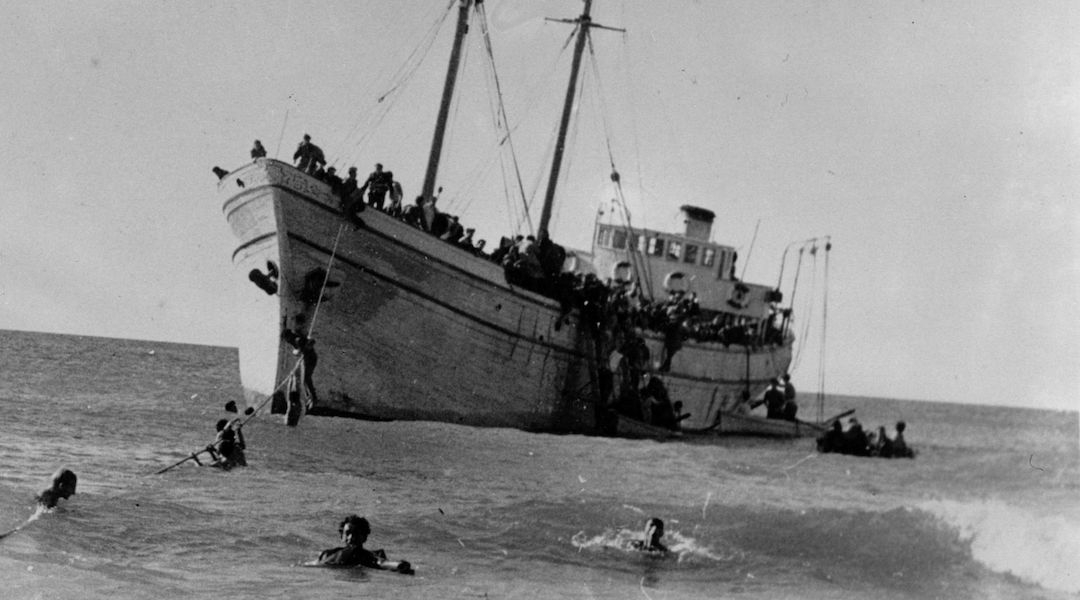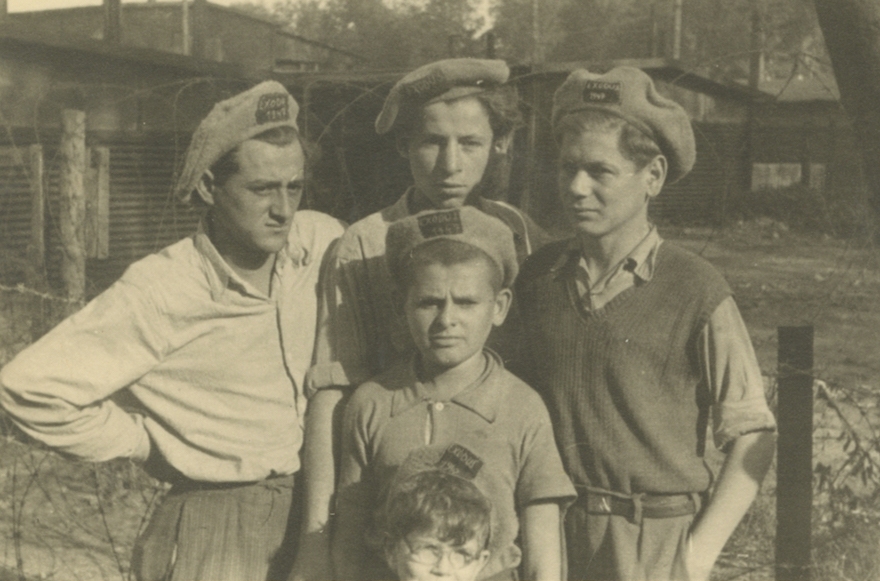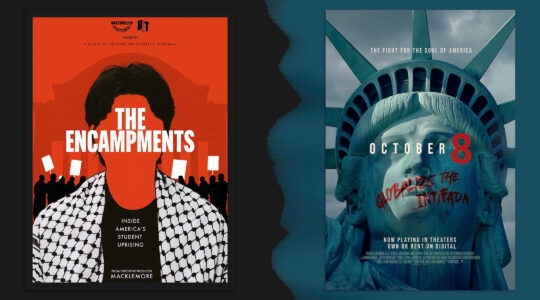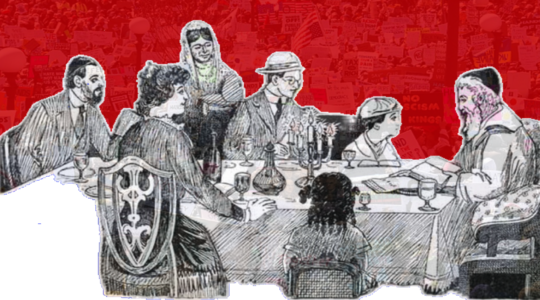(New York Jewish Week) — For hundreds of thousands of displaced people, World War II did not end in September 1945. The devastation of war created refugees from Eastern Europe and the liberated concentration camps, unwilling or unable to return home and forced into displaced persons camps in conquered Germany under allied protection.
In his new book, historian David Nasaw explains in vivid detail what happened to these beleaguered people, who ranged from shattered Jewish Holocaust survivors to stateless slave laborers to Nazi collaborators who feared going home to their now Soviet-dominated homelands. “The Last Million: Europe’s Displaced Persons from World War II to Cold War” (Penguin Press) tells familiar stories – like the illegal immigration of Jews to British-controlled Palestine – and forgotten stories like America’s shameful refusal to open its gates to Holocaust survivors while welcoming war criminals.
Nasaw is the author of prize-winning biographies of Joseph P. Kennedy, Andrew Carnegie and William Randolph Hearst, and until 2019 was the Arthur M. Schlesinger, Jr. Professor of History at the CUNY Graduate Center. He spoke with The Jewish Week from his home on the Upper West Side.
New York Jewish Week: Your book begins with the chaos right after the war ends in 1945, and the homeless and stateless people who survived, especially in Germany. Who were these displaced people?
David Nasaw: There are three distinct groups. The largest groups are the Polish forced or slave laborers. The Germans needed to replace the millions of soldiers sent to the eastern front, in the mills, mines and farms. So they asked for volunteers, and when those volunteers weren’t forthcoming they literally kidnapped millions of young people, from Poland, Ukraine and Eastern Europe, and brought them to Germany to spend the war as forced laborers, with insignias on their coats, saying they were untermenschen.
The second group comes into Germany right at the end of the war, from Lithuania, Latvia, Estonia and some from Ukraine in flight from the Red Army. Many of them had collaborated in one way or the other with the Nazi occupation forces. They knew they would be punished once the Germans were expelled, and many more feared communist domination.
The third group are the Jews. As the war comes to an end, the Nazis attempt to obliterate all evidence of the death camps. They take down the structures, burn the corpses, line up the Jewish survivors and death march them to Germany, not to save their lives, but because they decided it would be better to work them to death in underground factories in Germany rather than to gas them in the death camps. More than half do not survive the trip, but at liberation there are 50,000 or more in the camps who comprise the Last Million.
The war is over. Why couldn’t they just go home?
Jews had no homes to go back to. The Lithuanians and Latvians refused to go back to homelands annexed by the Soviet Union. Young Poles are frightened to death: Their country has been ripped in half, all the large parts of the east are annexed to the USSR. The Soviets now dominate the government, and these young Poles in the DP camps are bombarded with propaganda telling them to remain in the camps or resettle anywhere in the world and prepare for a war of liberation.
Who was responsible for caring for these displaced people?
Already in 1943 President Roosevelt understands that when the war is over, there will be millions of refugees. The only solution is through an international organization. Dozens of nations come to Washington and they sign onto the United Nations Relief and Rehabilitation Authority. It precedes the foundation of the U.N. It is designed to take care of the refugees and send them home again. When the war is over, the British and U.S. military supply the food, the protection, the medical, and UNRRA administers them on a day-to-day basis.
How many displaced persons camps were there? Were they all segregated by nationality and, in the Jews’ case, by religion?
There are hundreds of camps scattered through Germany, mostly in Bavaria, a few dozen in Austria, some in Italy. The famous Cinecittà film studios in Italy becomes a DP camp. Some are huge with thousands of DPS, others are tiny with a hundred or more.
In the beginning each camp is designated for a particular nationality. In the first few months after liberation, the U.S. and British and UNRRA don’t regard Jews as a nationality and as an entity that deserves its own camps, and lump them in with other Poles. The Jews ask, “How can you do this to us, placing us with the people who oppressed us?” In many cases, Polish Jews find themselves in camps with people from their hometowns whose families had robbed them of everything they owned, or former camp guards who had escaped into the DP camps. It’s not until July 1945 that a special envoy from Roosevelt recommends that the Jews be given special treatment, and Eisenhower goes through the camps, and tells commanders, “I want Jews only in these camps, with Yiddish-speaking counselors, special rations, all the medical supplies they need.”
You show a story of amazing resilience, as the various DPs created these sort of autonomous states where they kept alive the traditions of their home countries.
Little Latvias, little Ukraines, Jewish shtetls are reborn in Germany, many behind barbed wire. They have their own theaters, orchestras, libraries, schools for the young, athletic teams. Jews have boxing and chess tournaments, with different camps competing against each other. While they are waiting to either return home or be resettled somewhere else in the world, they want to keep some notion of peoplehood, of nation, together and alive.
The Jews who had no homes to go include concentration camp survivors who were in Germany as well as Polish Jews who survived the war in the Soviet Union. How many were there and why couldn’t they go back to Poland?
When the concentration camps open up and Jews come out of hiding, whether in Poland or Germany, their first thought is to go home and see if anybody survived. They hitch rides on trucks with soldiers, take trains, walk hundreds of miles. When they return the story is always the same: They go to the local Jewish center or post office to see if there are any messages from relatives, then they go to former homes and knock on their doors. A Pole answers and says, “You don’t live here anymore, there is no place for you, we thought the war killed you all.” The Poles took their homes, apartments, fields, stores and farms, and in 1945 they don’t want to give them back. It was all they had.
The anti-Semitism in Poland is exacerbated by the Germans, who say to the Poles that not only is it okay to be anti-Semitic but required. The Jews who return home from Germany, from captivity, and the more than 200-250,000 who escaped into the Soviet Union, come back to Poland, and the vast majority, 80, 90 percent, realize they cannot survive in Poland. They gather their belongings, pay bribes with the help of Brichah, the former Jewish partisans organization, and cross the borders into Germany through Czechoslovakia and Austria. The irony of ironies is that the only place in the world where they are safe is in Germany, in a displaced persons camps, protected by American soldiers.
A big part of this story is the reluctance by the world, including the United States, to resettle these Jews.
A painful, painful story. We have grown up – Jews who were children in the 1950s – with the belief that after six million had died, America, having neglected to assist the Jews, when the war is over opened its arms and gates to the survivors and they poured in. The reality is very, very different. The United States in ’45, ’46, ’47, ’48, ’49, kept out the Jewish survivors. Every nation on earth kept the Jews from resettling.
By ’47, ’48, the nations that had belonged to UNRRA and now the International Refugee Organization sent labor recruiters to the camps. Belgians needed miners, the British needed nurses, Canadians and Australians need farmers and railroad workers. Recruiters go into the camps to pick and choose those of the last million who they want to accept for resettlement. In every case, they chose first the Latvians, the Lithuanians, the Poles and would have nothing to do with the Jews.
What accounted for the reluctance of the U.S. to absorb what, at a few hundred thousand, does not sound like very many people?
An abiding anti-Semitism is not the whole reason. Jews were considered subversives, communists, rebels, troublemakers, and the world war quickly gave way to cold war, and with it the notion that Hitler had been defeated and what we have to worry about is the communists. This was a lie that Hitler had told over and over again, that the Jews are not only a biological poison but subversives.

Jewish refugees swim to shore from the SS ‘United Nations’ (formerly the Archimedes) near Haifa, 1948. It sailed from Bari, Italy, evading vessels of the British blockade on the way. (Keystone/Getty Images)
Most Jews would have preferred to have gone to Palestine, but that way was blocked by the British, who were in control of the Holy Land. President Truman was unable to persuade the British to open Palestine to Jewish migration. Was this a moral failing on the part of Great Britain, or simple realpolitik?
There is no doubt that the British upper classes and governing classes were frighteningly anti-Semitic and had always been so. But more than that, the British realized at the end of the war – and it is not Churchill in power, but the Labour government that had always been friendly to the Jews – that Great Britain is no longer a great power. India would have to be given up, the empire will shrink and in order to maintain any standing and economic leverage they have to hold onto the Middle East and be friendly with the Arabs. The only way to do that is to restrict Jewish immigration.
By 1947, Truman realizes the British will keep Palestine closed, and by 1948 there is no way to convince Congress to let into America large numbers of Jewish survivors. He has to get the 250,000 Jews out of Germany, which has to be done in order to establish an independent German state, which he can’t do with Jews in concentration camps on German soil. So Truman supports the partition of Palestine in 1947, and in 1948 supports Israel’s independence — not because he is a Zionist, but in part for humanitarian concerns, and more than that geopolitical concerns.
You write about the particularly nasty debates in Congress, especially the opposition by midwest Republicans and southern Democrats to absorbing Jews. What were their objections – simple anti-Semitism? Was there any merit to the argument that Polish Jews were sympathetic to communism, because the Soviets had sheltered them during the war?
The organized U.S. Jewish community is divided in ’45, ’46. The Zionist community says, let all the Jews go to Palestine, period, end of story. The larger American Jewish organizations, like the American Jewish Committee, say Jews should have the opportunity to come to the U.S. if they want. AJC is so fearful, however, of anti-Semitism in Congress, that instead of arguing that Jews deserve to be let in because of their unique suffering during the war, it forms a coalition with Catholic and Protestant organizations and sets up this campaign to let in displaced persons – not Jews as Jews. If a bill is passed, Jews, who make up a quarter of the refugees, will come in that way.
The opposite happens. The bill passed in 1948 renders ineligible the 90 percent of Jews who had come into Germany after 1946, six months after the war ended, because they had come from the USSR or gone home to Poland. No one in Congress was going to stand up and say what Hitler said about the Jews. Instead they refer to these “communist subversives,” and they continually talk about “we don’t dare let these people in because they are going to cause trouble.” The dialogue, the speeches by the southern Democrats and midwestern Republicans are frightening to behold. A new form of anti-Semitism resounds through the halls of Congress.
A revised displaced persons bill in 1950 eliminates the restrictions, but by 1950 200,000 Jews have moved to Palestine. Of the 250,000 Jewish survivors who became displaced persons, only 50,000 come to the United States. In subsequent years, larger numbers come from Israel to the United States but not as displaced persons and not until the middle ‘50s.
Tell me about the role of former NYC Mayor Fiorello LaGuardia in this – he seemed to be in a no-win position as head of efforts to resettle the displaced.
The first head of UNRRA is Herbert Lehman, a Jew, a politician and a close friend of Roosevelt. Lehman remains in office about a year or so, then resigns to run for office in New York again. He is replaced by LaGuardia, who takes on an impossible position, because UNRRA is pledged to rehabilitate and repatriate the DPs, and LaGuardia knows that is virtually impossible. He focuses his attention on the Poles, who he bribes to get out of the camps, providing them with large packages of goods that they can bring back to Poland. The Jews he doesn’t know what to do with.
Eventually the agency he heads is abolished, and it is replaced by the IRO — its mandate is not repatriation but resettlement. The Soviets refuse to join, because they have argued all along that all displaced persons should go home and those who don’t want to go home are either lazy and don’t want to rebuild their countries, or they are war criminals.
The state of Israel declared independence in 1948 after the British left the Holy Land. Did this resolve the crisis?
The Jews, the survivors, recognized that the only place they are going to be welcome is Palestine. They became Zionist by necessity. Those who never thought of going to Palestine before realized it was the only way they were going to be safe. The exodus, the aliyah to Israel, begins in ’46, ’47. It is the illegal aliyah, Aliyah Bet, aided by Mossad. Tens of thousands are transported out of the camps and illegally try to enter Palestine. Some do. But quickly the British realize they have to stop this illegal immigration, and pressure other countries to not let any ships leave their ports, or they meet the ships in Haifa and put the displaced persons in camps in Cyprus. That’s the Exodus story we all know.
With independence Ben-Gurion says he will give priority to those who can fight in the war, but for the most part, he says Israel has a moral obligation to accept them all and establish a Jewish majority. The massive migration begins. It’s not a happy, wonderful story because the survivors have gone through years of war, years in DP camps, and now are sent to their Promised Land, but their Promised Land is at war. The Israelis don’t know quite what to do with these people. They don’t speak Hebrew. Many are frail, shattered or ill.
From 1945 onward American immigration policy was based not on reality but on lies and falsehoods.
Another irony of ironies is that the vast majority of the displaced persons are resettled in farms, agricultural settlements, apartments and houses that had once belonged to Palestinians who had fled before the war or who had been expelled by Jewish militias or the Israeli army during the war. So in order to find homes, in order to resettle the Jews, in order to find the Jewish displaced persons solution, the Palestinian refugee problem is created.
The Cold War is very much a reality in your book – how did it shape both U.S. immigration policy and the fate of the Last Million?
The Cold War begins with establishment of the DP camps. The Soviets are convinced that the United States is warehousing anti-communists in preparation for a third world war. The Soviets have long memories; they remember that after World War I the allies tried to overthrow the Bolshevik government, and they believe after World War II the allies are going to try and overthrow Stalin’s government. Stalin and his representatives to the U.N. say over and over, “Why are you feeding and sheltering hundreds of thousands of Poles and Latvians and Lithuanians? Send them home!” And when the United States says no, the Cold War is begun.
In reality, what begins to happen, the CIA, the military and the State Department begin sorting out not only German scientists like Werner von Braun with Nazi backgrounds, but we begin to bring in war criminals and collaborators because we expect them to be the vanguard in a third world war.
We have a global refugee and resettlement crisis as we speak. How do the patterns you write about in the book relate to where we are in the 21st century? I often think that so long as countries have their own nationalist and political concerns, “never again” is just a slogan.
From 1945 onward American immigration policy was based not on reality but on lies and falsehoods. The Jewish survivors were kept out because they were accused of being communists, when the vast majority were not sympathizers or operatives or spies, but this lie determined U.S. refugee policy. Today, instead of looking at the immigration problem realistically, elected representatives repeat these falsehoods about drug dealers and criminals and terrorists and loafers who want to force our borders and not become citizens and workers. We sacrifice our humanitarian interests by provoking fear of the stranger, of the other, of the foreigner.
Second, today there are millions of innocent civilians who are victims of civil wars and wars between states. Roosevelt knew that the only way to solve an international crisis is through international cooperation. And it is dismaying, to put it mildly, that the lesson FDR tried to teach the nation has been forgotten. Instead of being a leader establishing a sane refugee policy and establishing international coalitions to solve this problem, we are withdrawing from the rest of the world.
The third lesson, taken from my book, is that it is not enough for the richer nations to simply throw money at the problem, to contain refugees in camps in Europe or Africa. It takes a concerted effort to get them out of the camps, to repatriate them safely in their homelands, and if that is not possible, resettle them elsewhere.
The New York Jewish Week brings you the stories behind the headlines, keeping you connected to Jewish life in New York. Help sustain the reporting you trust by donating today.






